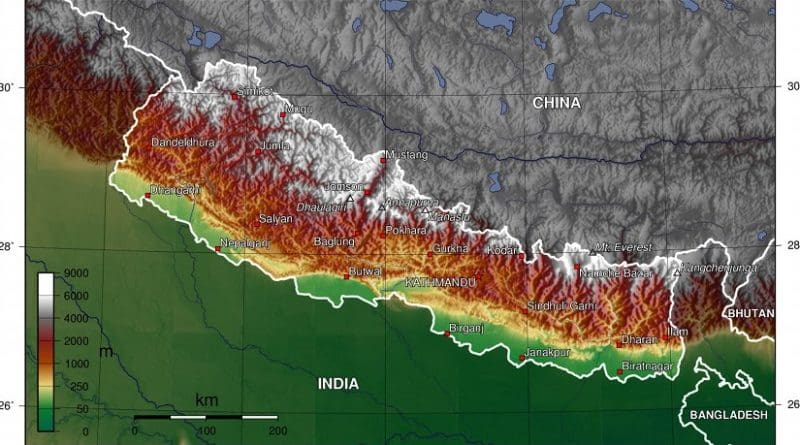Nepal: Frozen In Time – Analysis
By SAAG
By Dr. S.Chandrasekharan
Nepal appears to be frozen in time. Consider the following:
- One year after two devastating earthquakes, little progress has been made in reconstruction, rehabilitation and in providing compensation to those affected.
- It took a decade for the transitional justice bodies to stir out of their slumber to call for complaints of victims of the civil war.
- The political mechanism formed to deal with the demarcation issue on the agitation of the Madhesis and led by the Deputy Prime Minister Kamal Thapa is sitting idle. Meantime the Madhesis have moved for another alliance with the Janajathis to renew the stir.
- The local bodies elections are yet to take place though these bodies have not existed since 2002.
For an external observer, one cannot but admire the stoic patience of the common people of Nepal, despite total inaction of the government and the serious economic decline. ( see last update)
The only positive aspect seen is the general euphoria of many in the valley and in the media on the way PM Oli had “stood up” to India and had begun to look up to China for connectivity, though it is too early to say whether China in the near or mid term China could meet Nepal’s requirements.
Though the Indian concerns are misplaced, it pleases the Nepalese media no end when the Indian media and some analysts are seen to be visibly anxious over this development.
Anniversary of two devastating Earthquakes of 25th April and 12th May:
Although the people of Nepal do not need an anniversary to remind them of the devastating earthquake last year, the occasion was observed with all it solemnity all over Nepal.
There was however no introspection as to why there has been no or little progress in relief distribution, reconstruction or rehabilitation of the earthquake victims.
- Reconstruction efforts have been restricted to removing rubble and bringing down unsafe and unstable structures. About 800,000 buildings have been destroyed in the earthquakes and none save a few have been rebuilt.
- Out of 777,00 families that were affected, hardly 700 of them have received their first instalment for their rehabilitation.
- 38000 class rooms were brought down and none have been rebuilt.
- One year on, the NRA is yet to decide on earthquake proof models for reconstruction. Of the proposed 17 different residential models, many of them have been found to be defective. External expertise on this vital issue could have been helpful but was either not sought or ignored.
- Barpak, the epicentre of the earthquake in Gorkha District continues to be a scene of devastation and ruins.
Tera Agitation:
With the government at the centre making no move on the political mechanism, the Terain groups have now teamed up with the Janajathi groups to form a grand alliance of 26 parties named “Sanghiya Samabesi Gathabandhan” and put forward a concept paper of 22 points. Having realised the futility of earlier violent protests that only resulted in the deaths of over 55 persons, the now threatened agitation is said to be a low key and Singha Durbar centric affair.
The Madhesis and the Janajathis have nothing in common except in being ignored by the government in the centre and the three leading political parties. Any combined protest low key or otherwise will not be a sustained one and the Madhesis should learn first to look after their interests.
It is my personal view that the political mechanism will continue to be a farce and therefore it is time for the Terai leaders particularly Upendra Yadav and Rajendra Mahato to give up their “agitational mode” and seek other ways to redress their grievances. With the leadership of the Nepali Congress going into non Koirala hands, there is an opportunity for the Terains to team up with the Nepali Congress.
Truth and Reconciliation Commission:
Ten years have gone by and the TRC is still in the process of receiving complaints. The victims of the civil war are still awaiting justice and the Maoists who are in power now with others are seen to be placing some hurdle or other in delaying justice. The latest demand of the Maoists is that those case already in courts should also be transferred to the TRC, a demand that is not only preposterous but against all laws!
Local bodies Elections:
Elections to local bodies were last held in 1997. In 2002 the then Deuba government dissolved them and from then on there has been no elections either at the grassroots level or to village or municipal councils or wards or beyond. This is an anomalous situation and there has been practically no presence of the government in the country for the last 14 years!
Just when the government is considering the local elections, the Madhesi groups have come up with a demand that it is for the federal provinces to demarcate the village, wards and municipalities before any elections could be held.
Therefore it appears to be fairly certain that elections to the local bodies may not take place in the near future.


Most of us need reconstruction of the house but governments only blows few rupees it doesn’t sufficient. we don’t need money but we need house to live.